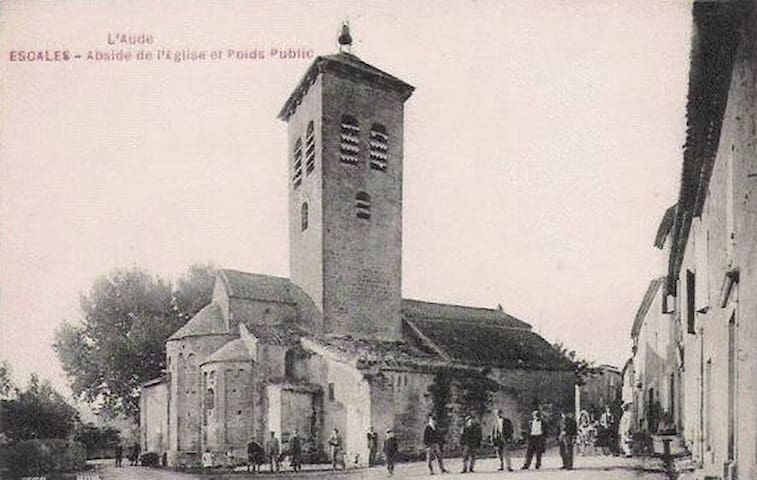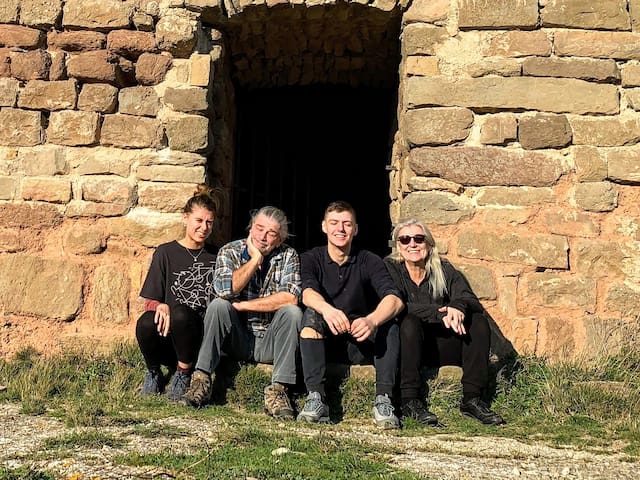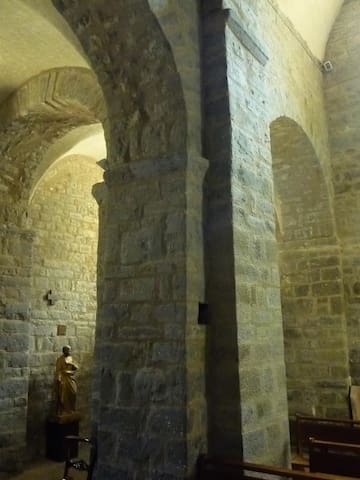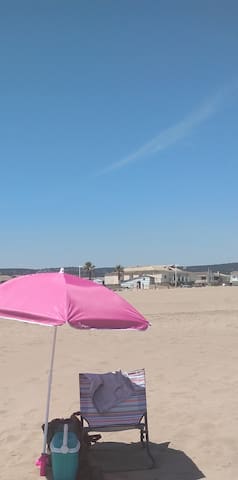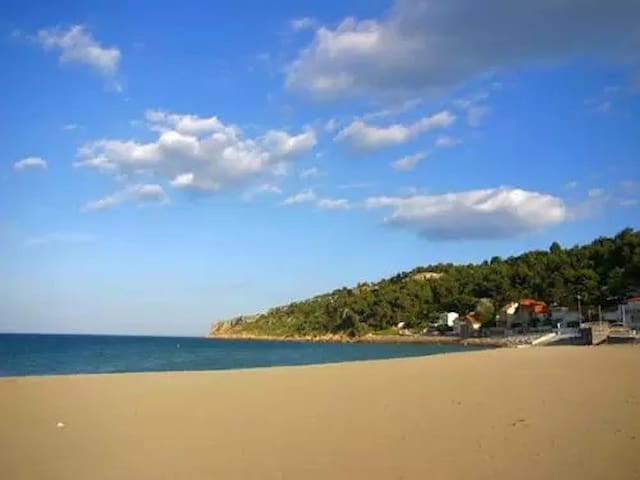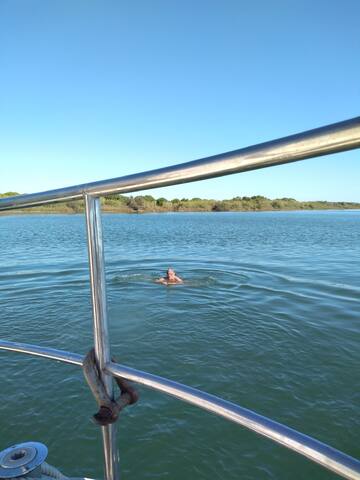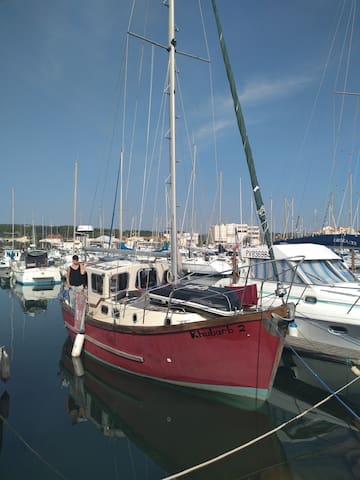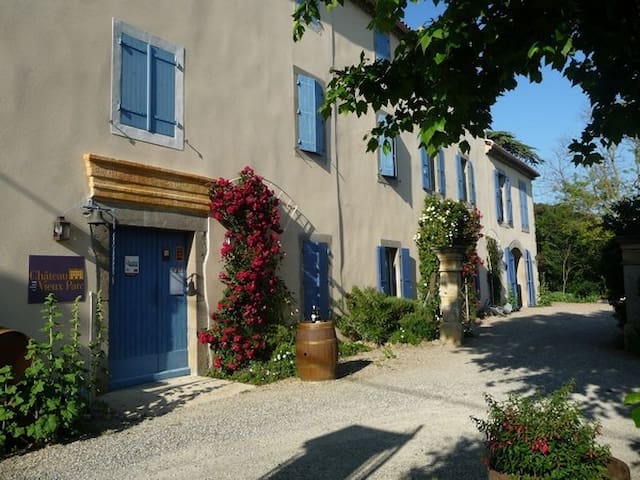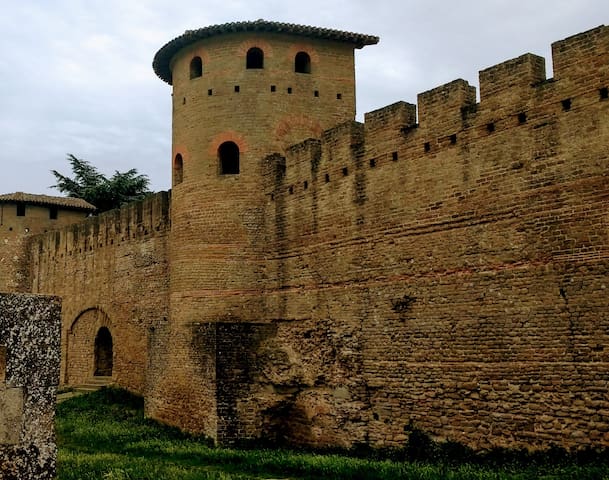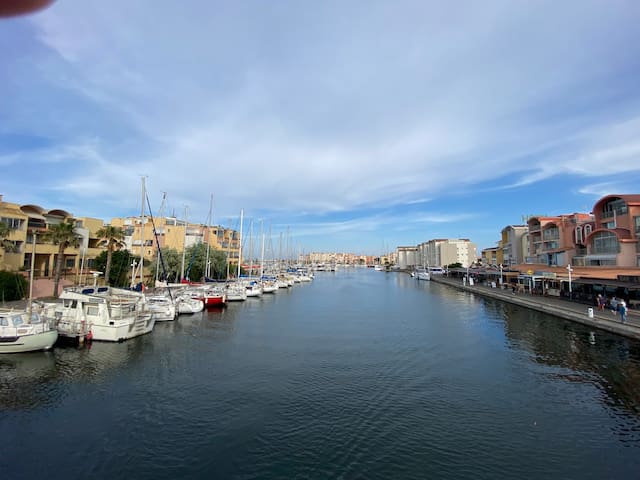Escales village
Escales is a commune in the Aude départment in southern France, principally involved in viticulture.
Escales lies in the northernmost part of the Corbières AOC wine growing area 30 km from Narbonne to the east, and 30 km Carcassonne to the west. Escales benefits greatly from its wine. It has a small factory called “Le Progrès” which joined forces with a neighbouring factory in Tourouzelle in 2006 to manufacture red, white and rosé wines. The factory was built in 1933 when 133 local winegrowers produced 10,210 hectolitres of wine.
Achille Mir, an Occitan poet of note lived in the village between 1801-1879.
Escales
Escales is a commune in the Aude départment in southern France, principally involved in viticulture.
Escales lies in the northernmost part of the Corbières AOC wine growing area 30 km from Narbonne to the east, and 30 km Carcassonne to the west. Escales benefits greatly from its wine. It has a small factory called “Le Progrès” which joined forces with a neighbouring factory in Tourouzelle in 2006 to manufacture red, white and rosé wines. The factory was built in 1933 when 133 local winegrowers produced 10,210 hectolitres of wine.
Achille Mir, an Occitan poet of note lived in the village between 1801-1879.
Within the boundary of the commune of Escales there are two important landmarks - the old tower (le donjon seigneurial) which necessitates a walk through a wooded hillside - and the church, which is situated in the centre of the village. The tower is a good example of a square fortress tower; it stands south-east of the village at a distance of approximately 1 km. The village cannot be seen from the tower base as the surrounding area is now wooded, however it is 100 metres higher than the village itself. Nowadays it lacks a large portion of the castellation. It was abandoned during the 17th century where, until that time, it was a quadrangular manorial home, with 1.90 metre thick walls. The tower was renovated and heightened in the 11th century from 6 to 18 metres. Its dual purpose was as a look-out tower preventing Spanish invaders marching on Carcassonne and a signaling tower using two lit torches sited on the upper platform. The upper platform was re-strengthened in 1980 where originally the main living area would have been found. Recent excavations have unearthed many pieces of black pottery and glass bottle shards which confirmed occupation from the beginning of the 11th to the 15th century.
La Tour d'Escales
Within the boundary of the commune of Escales there are two important landmarks - the old tower (le donjon seigneurial) which necessitates a walk through a wooded hillside - and the church, which is situated in the centre of the village. The tower is a good example of a square fortress tower; it stands south-east of the village at a distance of approximately 1 km. The village cannot be seen from the tower base as the surrounding area is now wooded, however it is 100 metres higher than the village itself. Nowadays it lacks a large portion of the castellation. It was abandoned during the 17th century where, until that time, it was a quadrangular manorial home, with 1.90 metre thick walls. The tower was renovated and heightened in the 11th century from 6 to 18 metres. Its dual purpose was as a look-out tower preventing Spanish invaders marching on Carcassonne and a signaling tower using two lit torches sited on the upper platform. The upper platform was re-strengthened in 1980 where originally the main living area would have been found. Recent excavations have unearthed many pieces of black pottery and glass bottle shards which confirmed occupation from the beginning of the 11th to the 15th century.
Le village d'Escales est développé autour d’une très belle église du Xe siècle. Cette église romane est dédiée à Saint-Martin et classée Monument Historique. Le chevet à triple absides, très sobre, est juste souligné par des bandes lombardes et un cordon de basalte noir au-dessus des ouvertures.
Église Saint-Martin d'Escales
Le village d'Escales est développé autour d’une très belle église du Xe siècle. Cette église romane est dédiée à Saint-Martin et classée Monument Historique. Le chevet à triple absides, très sobre, est juste souligné par des bandes lombardes et un cordon de basalte noir au-dessus des ouvertures.
Beaches
Nearest beach to Escales. Miles of golden sands, buy fresh fish, see the famous chalets.
121 personas locales recomiendan
Gruissan Plage
Nearest beach to Escales. Miles of golden sands, buy fresh fish, see the famous chalets.
The beach is equipped with a first aid post number during the summer period.
The station is adapted for people with reduced mobility with a shower, a rolling mat and a tiralo for access to the water.
It is also equipped with a defibrillator. Pets not accepted.
Plage du Sardinal
2 Av. Capitaine DelestrainThe beach is equipped with a first aid post number during the summer period.
The station is adapted for people with reduced mobility with a shower, a rolling mat and a tiralo for access to the water.
It is also equipped with a defibrillator. Pets not accepted.
La Franqui, nestled in a pine forest, is the oldest resort on the Languedoc coast and home to the fabulous Plage des Coussoules, 8km of fine golden sand, where the Phoenician galleys anchored. Home of Henry de Monfreid, the adventurer and writer, La Franqui offers you the possibility of windsurfing, kitesurfing and sand yachting at the foot of the cliff. It remains the meeting place for sportsmen and women who are passionate about water sports.
45 personas locales recomiendan
Plage de la Franqui
La Franqui, nestled in a pine forest, is the oldest resort on the Languedoc coast and home to the fabulous Plage des Coussoules, 8km of fine golden sand, where the Phoenician galleys anchored. Home of Henry de Monfreid, the adventurer and writer, La Franqui offers you the possibility of windsurfing, kitesurfing and sand yachting at the foot of the cliff. It remains the meeting place for sportsmen and women who are passionate about water sports.
Port-Leucate is one of the largest marinas in Europe in terms of surface area, with 1500 moorings on a sandy lagoon between the sea and the lake. Follow in the wake of the Phoenician and Greek sailors of antiquity. Discover the astonishing white cliff which gave its name to Leucate, and come and stop over between the sea and the lake, in a privileged and grandiose site.
Leucate-Plage, well sheltered from the whims of the Tramontane by the cliff, with its small preserved creeks, or its immense wild beach, has attracted families for generations.
71 personas locales recomiendan
Leucate
Port-Leucate is one of the largest marinas in Europe in terms of surface area, with 1500 moorings on a sandy lagoon between the sea and the lake. Follow in the wake of the Phoenician and Greek sailors of antiquity. Discover the astonishing white cliff which gave its name to Leucate, and come and stop over between the sea and the lake, in a privileged and grandiose site.
Leucate-Plage, well sheltered from the whims of the Tramontane by the cliff, with its small preserved creeks, or its immense wild beach, has attracted families for generations.
Narbonne plage is a resort on the southern (Mediterranean) coast of France in the Aude department. It is separated from the city of Narbonne by the limestone massif Montagne de la Clape and lies at its foot. The beach currently holds blue flag status, an award it has held on multiple occasions.
Narbonne-Plage
Narbonne plage is a resort on the southern (Mediterranean) coast of France in the Aude department. It is separated from the city of Narbonne by the limestone massif Montagne de la Clape and lies at its foot. The beach currently holds blue flag status, an award it has held on multiple occasions.
Dégustations / Wine Tasting
Situated on the north end of the Appellation “Corbières“, in the Aude county, 5 km from Lézignan- Corbières.
Nestled in a green setting surrounded by maritime essences, this impressive chateau which had already been mentioned in topographical layouts of 1770 and refurbished several times, offers a unique character.
Château La Bastide is ranked first in numerous tastings including: USA, Canada, England , Benelux, Germany, Japan, China and other countries where 100 % of the area of production is exported.
Château la Bastide, crus Corbières
Situated on the north end of the Appellation “Corbières“, in the Aude county, 5 km from Lézignan- Corbières.
Nestled in a green setting surrounded by maritime essences, this impressive chateau which had already been mentioned in topographical layouts of 1770 and refurbished several times, offers a unique character.
Château La Bastide is ranked first in numerous tastings including: USA, Canada, England , Benelux, Germany, Japan, China and other countries where 100 % of the area of production is exported.
Château de l'Horte is situated in the middle of the vineyards in Montbrun des Corbières between picturesque Narbonne on the Mediterranean coast and historic Carcassonne. Our visitors are welcome to a tour of the cellar and of course .... a wine tasting.
Château de L'Horte
Route d'EscalesChâteau de l'Horte is situated in the middle of the vineyards in Montbrun des Corbières between picturesque Narbonne on the Mediterranean coast and historic Carcassonne. Our visitors are welcome to a tour of the cellar and of course .... a wine tasting.
Organic: The estate is made up of several grape varieties: Old Grenache noir and Carignan, Grenache gris, Cinsault, Syrah. For some time, we have made our commitment to respecting the living environment official. All our wines are certified AB, DEMETER and VIN METHODE NATURE. Respect for the earth and the vines leads us to work manually most of the time in order to avoid soil compaction. The grapes are harvested by hand in order to keep them intact until the vatting process.
Les Clos Des Pères
11b Chem. des CondominesOrganic: The estate is made up of several grape varieties: Old Grenache noir and Carignan, Grenache gris, Cinsault, Syrah. For some time, we have made our commitment to respecting the living environment official. All our wines are certified AB, DEMETER and VIN METHODE NATURE. Respect for the earth and the vines leads us to work manually most of the time in order to avoid soil compaction. The grapes are harvested by hand in order to keep them intact until the vatting process.
Between Carcassonne and Narbonne, Château du Vieux Parc was built over centuries in this beautiful landscape rich in flora and fauna. The private estate is located on the Terroir of Lezignan in the small village of Conilhac Corbières and includes 40 hectares of AOP Corbières and 30 hectares of Vin de Pays.
The terroir is composed of clay and limestone slopes and stony, south-facing terraces. The climate is Mediterranean –hot and dry with very little rainfall between June and October. Protected by the Alaric Mountain to the west, the rainclouds rarely reach the village. The dominant wind, named Cers or tramontane, sculpts the landscape and is perfect for the ripening of grapes.
Red grape varieties include: carignan, syrah, grenache, mourvèdre, cinsault, merlot, cabernet sauvignon , cabernet franc.
White and rosé grape varieties: roussanne, vermentino, viognier, grey grenache and cinsault.
We pride ourselves on practicing sustainable farming, which respects the land in its limited use of pesticides and other chemical treatments. The estate has been certified HVE (Haute valeur environnementale) level 3 since 2017.
CHATEAU DU VIEUX PARC
1 Avenue des VigneronsBetween Carcassonne and Narbonne, Château du Vieux Parc was built over centuries in this beautiful landscape rich in flora and fauna. The private estate is located on the Terroir of Lezignan in the small village of Conilhac Corbières and includes 40 hectares of AOP Corbières and 30 hectares of Vin de Pays.
The terroir is composed of clay and limestone slopes and stony, south-facing terraces. The climate is Mediterranean –hot and dry with very little rainfall between June and October. Protected by the Alaric Mountain to the west, the rainclouds rarely reach the village. The dominant wind, named Cers or tramontane, sculpts the landscape and is perfect for the ripening of grapes.
Red grape varieties include: carignan, syrah, grenache, mourvèdre, cinsault, merlot, cabernet sauvignon , cabernet franc.
White and rosé grape varieties: roussanne, vermentino, viognier, grey grenache and cinsault.
We pride ourselves on practicing sustainable farming, which respects the land in its limited use of pesticides and other chemical treatments. The estate has been certified HVE (Haute valeur environnementale) level 3 since 2017.
Sightseeing
Travel back in time ... fantastically restored medieval city.
482 personas locales recomiendan
Carcassonne
Travel back in time ... fantastically restored medieval city.
Lovely seaside town with picturesque harbour, castle, casino, many seafood restaurants.
169 personas locales recomiendan
Gruissan
Lovely seaside town with picturesque harbour, castle, casino, many seafood restaurants.
The Cistercian Abbey of Fontfroide is nestled in the foothills of the Corbières, south-west of Narbonne. Founded in 1093, Fontfroide, now classified as a Historic Monument and Grand Site of Occitanie, crosses centuries, eras and events, witnessing history for present and future generations.
236 personas locales recomiendan
Abbaye de Fontfroide
RD 613 Route Départementale 613The Cistercian Abbey of Fontfroide is nestled in the foothills of the Corbières, south-west of Narbonne. Founded in 1093, Fontfroide, now classified as a Historic Monument and Grand Site of Occitanie, crosses centuries, eras and events, witnessing history for present and future generations.
Food scene
Le Spot
Lovely location right on the Canal du Midi.

